How an unintentional discovery in a messy lab ushered in a new era for infectious diseases.
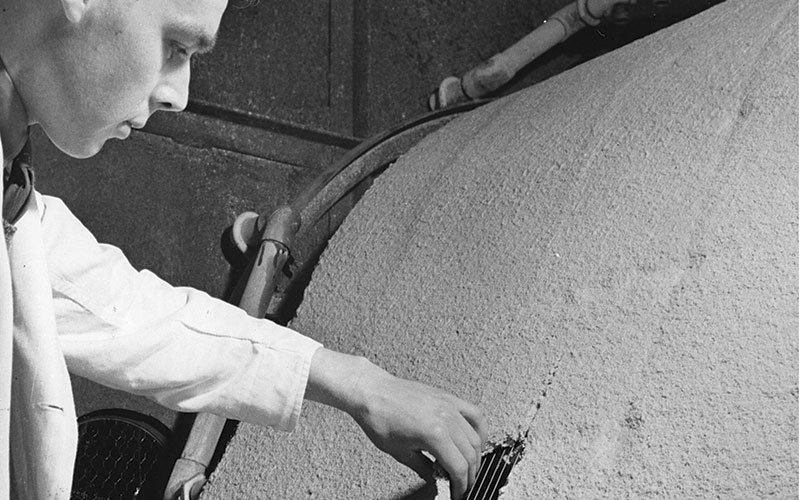
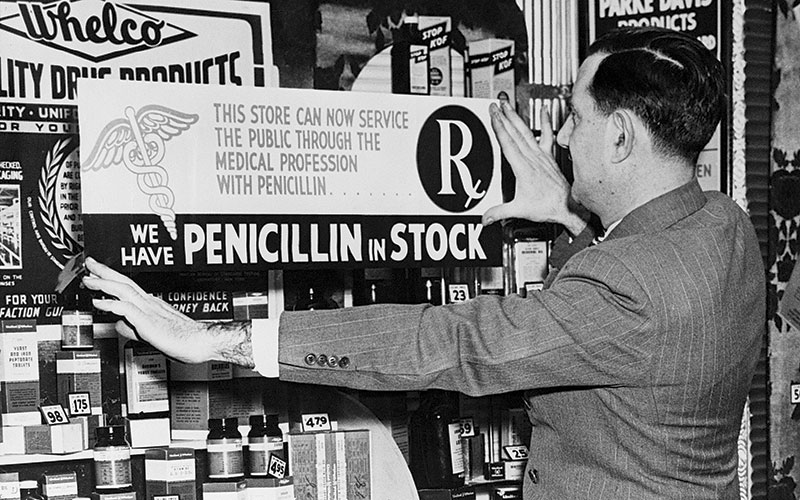
A small piece of matter might have come in through the open window, landed on the plate and started to grow. But odder still, and far more important, was the effect it had created. For while the rest of the plate was a sea of staphylococcus spots, the area around the mould was free of any sign of the bacteria. It was as though some property of the “mould juice”, as Fleming called it, was resisting the spread of the staphylococcus. From that moment, from that happy accident, the modern era of the antibiotic flowered.
Fleming and his assistants later identified the mould as “penicillium” and found that it was just as effective against other bacteria, including streptococcus and meningococcus. He was quick to announce his findings in an article in the British Journal of Experimental Pathology in 1929, writing: “The staphylococcus colonies became transparent and were obviously undergoing lysis… the broth in which the mould had been grown at room temperature for one to two weeks had acquired marked inhibitory, bactericidal and bacteriolytic properties to many of the more common pathogenic bacteria.”
But while observing the effects of the mould and replicating it to a small degree were one thing, pinning down the vital ingredient and understanding how it worked were quite another.
“Fleming discovers what he calls penicillin, but it is just a yellow liquid,” says Robert Bud, Research Keeper at the Science Museum and author of the book Penicillin: Triumph and Tragedy. “It’s not what we know as penicillin at all. The metaphor I have is that Fleming is a sort of Christopher Columbus. He says that he has found something, but he doesn’t know what it is.”
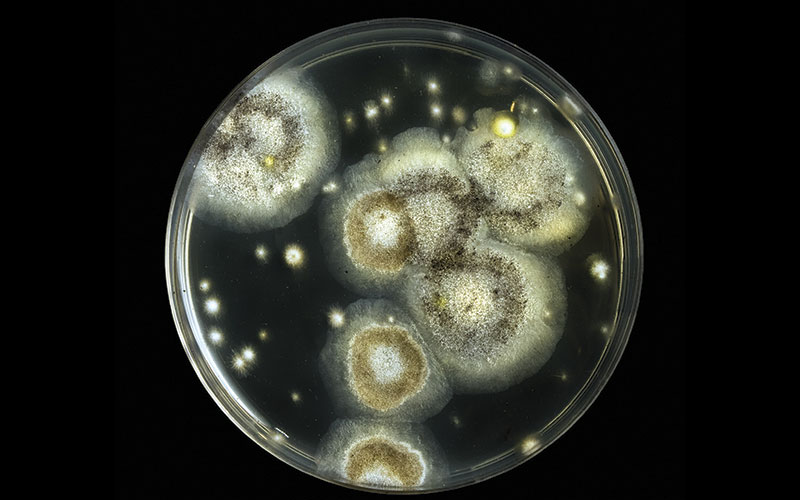
Halting progress
Part of the problem for Fleming was that, try as he might, the chemistry to properly isolate and grow penicillin in suitable quantities didn’t exist in the late 1920s. He also ran into a degree of scepticism, as the lure of a “wonder drug” was not something to easily sway a society that had seen more than enough quack medicine. As a result, Fleming couldn’t capitalise on his discovery, and the promise of penicillin and its antibacterial action lay dormant.
Despite the stuttering attempts of Cecil Paine at the Sheffield Royal Infirmary to use penicillin to treat patients with eye infections in 1930, it wasn’t until 1939 and the work of a group at the Sir William Dunn School of Pathology at Oxford University that included Howard Florey, Ernst Chain and Norman Heatley that Fleming’s findings were successfully revisited. They learnt more about the mould’s chemical and therapeutic properties, found how to isolate the key active ingredient, and devised a way to produce penicillin in sufficient quantities to begin formal testing on live subjects.
The equipment was still crude, though, and the onset of World War Two wasn’t about to make it any easier. With materials in short supply, they press-ganged every suitable container they could find to hold the solution that would produce the mould – milk churns, bell jars, bath tubs and even bed pans.
It worked well enough, and in 1940 the team carried out its first experiments on mice infected with streptococcus. The rodents left to their own devices died, while those injected with penicillin survived. Emboldened by their success, the team began looking for a suitable human subject. They found it in the shape of Albert Alexander, a police constable hospitalised at the Radcliffe Infirmary in Oxford. A rose thorn had scratched his face and the wound had become infected with staphylococcus and streptococcus, causing severe abscesses on his face, eyes, scalp and lungs. Having done all they could, the doctors accepted an offer of help from Florey and his team.
They moved in and immediately set about injecting Alexander with penicillin. Before long, and to everybody’s astonishment, he showed signs of recovering. His abscesses started to heal and he was even well enough to eat. But after just five days the team exhausted its meagre supply of the drug, and it hadn’t been enough to kill off the infection completely. Alexander’s condition deteriorated and this time there was no saving him.
Moving abroad The wartime shortages and regulations were hampering the team’s efforts to produce a more workable form of penicillin, and so they began to look across the Atlantic for help – Florey in particular had good connections in the US. But there was more to it than just a lack of resources, says Robert Bud: “Another fundamental issue is the technology of fermentation. It requires a lot of surplus organic material, which is what the Americans have. Corn starch, maize and so on. Not only would the British have had to import this, a tall order at that point in the war, they no particular expertise in fermentation.”
Foley found what they needed at the US government’s Northern Regional Research Laboratory (NRRL). It had set up operations in Peoria, Illinois, in the heart of the American midwest, where the required organic material was abundant. It also had a specialist fermentation division that had been developing extensive expertise in the technology since the end of the First World War.
Working with the Oxford team, the NRRL fermentation division began to apply all its skill and experience to the job of boosting the production of penicillin to the sort of industrial levels that would make the wonder drug more viable – thousands of litres of solution were needed to create enough to treat just a single infection.
This broke down into three key tasks: improve the submerged fermentation technique, devise a way to speed up the growth of the mould, and find a strain of penicillin that would deliver higher yields.
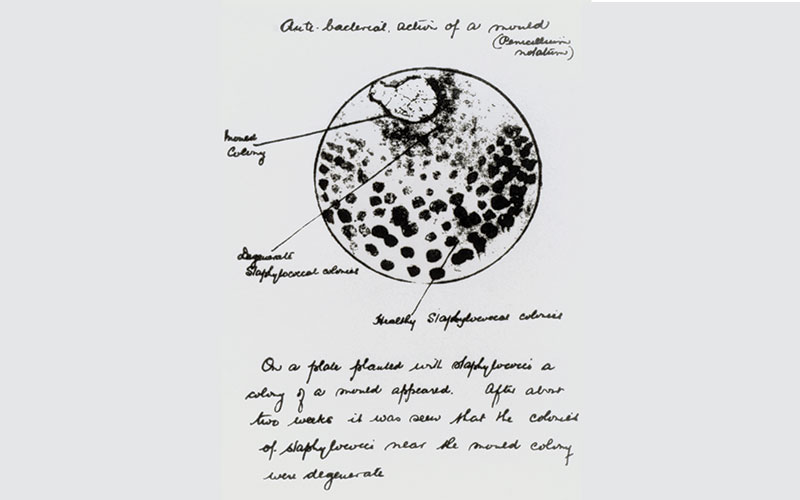 Perfecting the process
Perfecting the process

NRRL had been using a patented fermentation process since the mid 1930s, where they grew the mould submerged in the solution rather than just on the surface of the containers. Whereas the fermenting process had been restricted to Fleming’s meagre plates in 1928 and the Oxford group’s improvised bath tubs in 1939 and 1940, it was now taking place in high-capacity rotating drums and vats, both of which could feed vital oxygen into the medium without breaking up and destroying the mould.
The next step was to substitute the Oxford team’s brewer’s yeast with a better growing agent. NRRL settled on corn steep liquor. This by-product of corn starch was in plentiful supply, and its potency at promoting mould growth had been recognised and exploited in the US just a few years earlier.
Finally came the quest to find a more productive strain of penicillin. Initially this involved collecting soil samples from wherever in the world the US Army could gather them, and shipping them back to Peoria for the scientists to analyse. This process was cut short when a mouldy cantaloupe found in a market in Peoria itself turned up in the lab. This yielded a mould known as Penicillium chrysogeum, which was 200 times more potent than the previous strain. Legend has it the vegetable was found by the lab assistant Mary Hunt, who as consequence earned the unlovely moniker of “Mouldy Mary”.
History is made
Taken together these advances pushed the production of penicillin onto a whole new scale. “From having it only in principle they go in a short time to having an actual working mass-production plant,” says Robert Bud. “And from the time the Oxford group get involved to the end of the war, we have one of the key breakthroughs in medical history.”
In 1943 the US pharmaceutical industry was producing millions of units of the drug a month; by 1945 it was billions. Whereas infection was once a major cause of death among combatants, penicillin had reduced it to a minor threat. Civilian populations began to get the benefits of the new wonder drug from 1945 onwards. The age of the antibiotic was here.
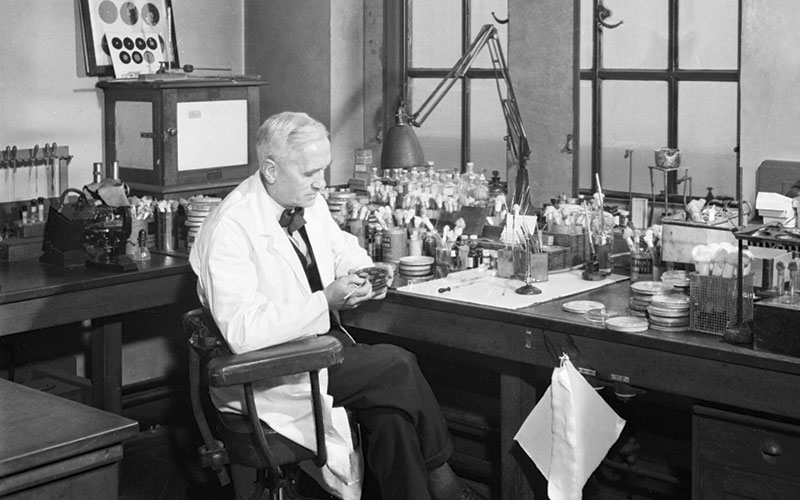
Yet another big step forward came in 1945, with Dorothy Hodgkin using X-ray crystallography to verify the chemical structure of penicillin, paving the way for its eventual synthesis in 1957. Also in 1945, Fleming, Florey and Chain were awarded the Nobel Prize in Physiology or Medicine “for the discovery of penicillin and its curative effect in various infectious diseases”. In just 17 years since that September morning, the new wonder drug had changed medicine beyond all recognition, though even then, in his acceptance speech, Fleming warned of the dangers of its misuse…
Image Credit Getty/Science photo library/IWM via Wiki/ Shutterstock




